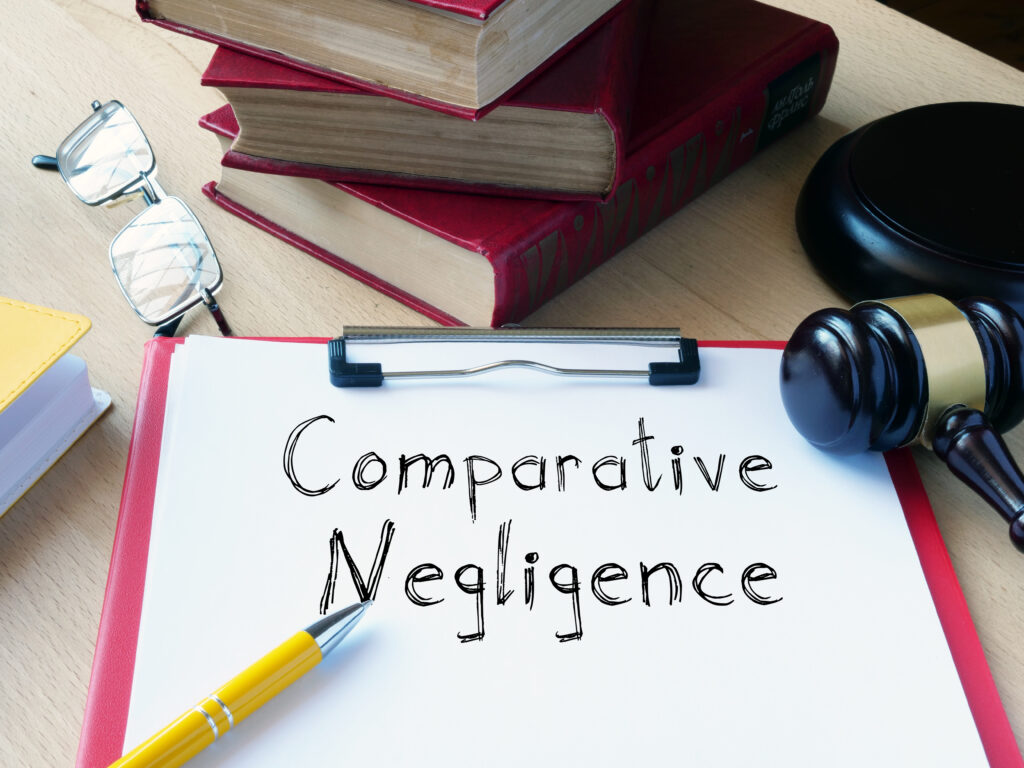After a serious Texas truck accident, medical bills might pile up while you recover from injuries. You may also face a damaged vehicle and stress about lost income. Determining fault is key because Texas’s comparative negligence rule affects your truck accident claim.
This rule directly impacts the money you might recover, and your potential settlement might be reduced if you share some blame for the crash. A Texas truck accident lawyer can help evaluate how fault might affect your claim and work to protect your right to compensation.
Understanding Texas Comparative Negligence

Texas uses a specific system to handle situations where more than one person might be at fault. This system is known as comparative negligence.
So, instead of one person being 100% at fault, the responsibility might be divided. Texas follows a specific version of this called modified comparative negligence. This approach directly influences how much money you might receive for your truck accident injuries and damages.
The basic idea is simple. Your compensation might decrease based on your percentage of fault. Courts or insurance companies assign a fault percentage to everyone involved in the truck wreck, determining how Texas’s comparative negligence rule applies to your claim.
How the Texas 51% Rule Works
Texas uses a 51% bar rule for shared fault situations. This is a critical part of Texas’s comparative negligence rule, sometimes called the proportionate responsibility system.
The rule means that you cannot recover any money if you are found to be 51% or more responsible for the truck accident.
If your percentage of fault is 50% or less, you might still recover damages. However, the amount you receive is reduced by the exact percentage of your fault.
Insurance companies often try to shift blame to reduce payouts, using the Texas comparative negligence rule to their advantage.
Determining Fault in Texas Truck Accidents
Assigning fault percentages isn't random. It involves a careful investigation into the crash details. Various factors contribute to determining who caused or contributed to the truck accident.
Common Causes of Truck Accidents
Many factors might lead to large truck crashes where fault is disputed. Understanding common causes helps investigators pinpoint responsibility. Some typical reasons include:
- Driver Fatigue: Truck drivers work long hours, and fatigue slows reaction times.
- Distracted Driving: Using phones, adjusting controls, or other distractions takes focus off the road.
- Speeding: Driving too fast for conditions or exceeding limits reduces stopping distance.
- Improper Lane Changes: Large trucks have big blind spots, making lane changes risky if not done carefully.
- Following Too Closely: Tailgating doesn't allow enough space to stop safely.
- Driving Under the Influence: Alcohol or drugs impair driving ability.
- Improper Cargo Loading: Unsecured or poorly balanced loads might shift, causing loss of control.
- Poor Vehicle Maintenance: Issues like worn tires or faulty brakes might lead to accidents.
Investigators examine these and other factors to understand how the Texas comparative negligence rule applies. Multiple factors might combine to cause a single accident. This complexity often leads to shared fault findings.
Evidence Used To Assign Fault
Determining fault requires strong evidence. Insurance adjusters and lawyers gather various types of proof, which helps create a clear picture of what happened just before, during, and after the truck wreck.
Key evidence often includes:
- The police accident report
- Witness statements
- Photos and videos of the crash scene, vehicle damage, and surveillance or dashcam
- Truck's black box data
- Driver logs and records
- Maintenance records
This evidence collectively helps assign percentages under the Texas proportionate responsibility rules. More evidence generally leads to a more accurate fault determination. Your lawyer plays a big part in finding and using this proof effectively.
The Role of the Police Report
The police report is often one of the first pieces of evidence reviewed. It provides an official summary of the accident scene. The report usually includes the officer's opinion on contributing factors and potentially who violated traffic laws.
However, the police report isn’t the final word on fault. Officers arrive after the crash and base their report on limited information available at the scene. Their assessment of fault might be preliminary or even incorrect.
Insurance companies might rely heavily on the report if it favors them. If the report unfairly assigns you blame, it's possible to challenge it. Additional evidence gathered later might contradict the officer's initial conclusions and affect how the Texas comparative negligence rule is applied.
Impact of Texas’s Comparative Negligence Rule on Your Compensation
Your assigned fault percentage changes the amount of money you might receive. This calculation applies to the total damages awarded.
Insurance companies are motivated to increase your percentage of fault. Even a small increase in your blame significantly decreases their payout under the Texas shared fault system.
Negotiating this percentage is a key part of the claims process, and an important reason why having a lawyer at the table is helpful.
51% or More at Fault
If the investigation concludes you were 51% or more responsible for the truck accident, you receive zero compensation. Being assigned 50% fault allows recovery (reduced by half), but 51% fault means nothing.
This strict cutoff underscores why fighting unfair blame is so essential when dealing with the Texas comparative negligence rule.
Types of Damages Affected
Comparative negligence affects the recovery of all types of compensatory damages. If your fault is determined to be 25%, your recovery for all these combined losses decreases by 25%. Protecting your right to full compensation involves minimizing any assigned fault.
Economic damages include:

- Medical Expenses: This category covers all reasonable and necessary medical care related to your truck accident injuries, including emergency room visits, hospital admission costs, surgeries, appointments with physicians and therapists, prescriptions, medical devices like crutches or wheelchairs, and any ongoing rehabilitation or physical therapy.
- Lost Wages: If your injuries prevent you from working, you might recover compensation for your lost income. This includes your regular salary or hourly pay and missed overtime opportunities, bonuses, or commissions you reasonably expected to earn during your recovery period.
- Loss of Earning Capacity: Loss of earning capacity compensates for a diminished ability to earn income over your expected working life due to your injuries.
- Property Damage: This covers the cost of repairing your vehicle to its pre-accident condition. If the cost of repairs exceeds the vehicle's fair market value, property damage covers the replacement value of your car.
Non-economic damages cover intangible losses that don't have a direct bill or invoice. Examples include:
- Pain and Suffering: This compensation covers the physical pain, discomfort, and general suffering you experience because of your truck accident injuries.
- Mental Anguish: This damage addresses the significant emotional and psychological distress stemming from the accident, like fear, anxiety, nervousness, grief, depression, or post-traumatic stress disorder (PTSD).
- Physical Impairment: When injuries lead to a loss of your ability to engage in daily life activities or enjoy hobbies you previously pursued, physical impairment damages apply.
- Disfigurement: If the truck accident causes permanent scarring, amputation, or other lasting changes to your physical appearance, you might receive compensation for disfigurement.
Statute of Limitations for Texas Truck Accident Claims
You have a limited time (statute of limitations) to file a lawsuit after a truck accident in Texas. Missing this deadline means you lose your right to seek compensation in court.
The general statute of limitations for personal injury cases in Texas, including truck accidents, is two years. This two-year clock usually starts ticking on the date the accident occurred. Waiting too long might prevent you from recovering damages, regardless of fault.
Investigating truck accidents and dealing with issues like the Texas comparative negligence rule takes time. The timeline would be even shorter if a government truck were involved. Contacting a lawyer soon after your accident helps protect your legal rights within this timeframe.
How a Lawyer Can Help With Your Texas Comparative Negligence Claim
Navigating a truck accident claim involving Texas’s comparative negligence rule is complex. Insurance companies have experienced adjusters and lawyers protecting their interests. Having your own legal representation levels the playing field.
Investigation
A Texas truck accident lawyer knows how to investigate crashes, gather crucial evidence, and build a strong case. This involves collecting witness statements, photos, or any data showing that the truck driver's actions caused the crash.
Calculating Damages
Calculating the full extent of your damages is another vital role that lawyers play in truck crash claims. They total your compensation package, including current and future medical costs, lost income, and non-economic losses like pain and suffering.
Accurately valuing your claim strengthens your negotiating position.
Countering Unfair Blame
Don’t simply accept the insurance company's determination of fault. Your lawyer will fight back against unfair blame. They highlight inconsistencies in the other driver's story or the adjuster's assessment and can point out specific traffic laws the truck driver violated.
Demonstrating the truck driver's negligence clearly is key to countering unfair blame under the Texas proportionate responsibility system.
Presenting a strong counter-narrative backed by evidence might shift the fault percentages. Your lawyer helps build this counter-argument effectively.
Handling Insurance Adjusters

Your lawyer handles communications and negotiations with the insurance company for you. Negotiation is a standard part of the insurance claim process. The trucking company's insurance adjuster might try to minimize the payout by leveraging Texas’s comparative negligence rule.
During negotiations, your lawyer presents your evidence and argues for a lower fault percentage (or none) for you.
Your lawyer can take the case to court if the insurance company refuses a fair settlement. They represent you throughout the litigation process, fighting to protect your rights.
FAQ for How Texas’s Comparative Negligence Rule Affects Your Truck Accident Claim
What If I Think the Police Report Got the Fault Wrong in My Texas Truck Crash?
The police report contains the officer’s initial assessment, but it's not legally binding proof of fault. If you disagree with the report, you might challenge it.
Your lawyer gathers additional evidence, like witness testimony, photos, videos, or expert analysis, to present a more accurate picture of events and argue for a different fault allocation.
This new evidence might persuade the insurance company or a court that the initial report was incorrect.
Can I Still File a Claim if I Was Partly to Blame for the Texas Truck Accident?
You might still have a case if you were partly to blame, as long as your share of fault is 50% or less. Texas law allows recovery if your responsibility doesn’t exceed the other parties' responsibility.
Your fault percentage reduces your potential compensation award, but you’re not barred from recovery unless you cross the 51% threshold under the Texas proportionate responsibility statute.
How Does Texas’s Comparative Negligence Rule Reduce My Settlement?
The Texas comparative negligence rule reduces your settlement amount based directly on your assigned percentage of fault. If your total damages are calculated at $200,000, and you are found 30% responsible for the accident, your potential settlement is reduced by that 30%.
This means you subtract $60,000 (30% of $200,000) from the total, leaving a possible recovery of $140,000. If your fault reaches 51%, the rule prevents you from recovering any money at all.
What Evidence Is Strongest for Fighting Fault Percentage in Texas?
Objective evidence tends to be the most persuasive for fighting fault percentages. It includes data from the truck's electronic logging device, dashcam or surveillance video footage, and analysis from accident reconstruction professionals.
Clear witness statements from unbiased third parties also carry significant weight. Physical evidence, like skid marks and vehicle damage patterns, helps reconstruct the accident sequence accurately.
Does the Texas 51% Rule Apply Only to Truck Accidents?
No, the Texas 51% modified comparative negligence rule applies to most personal injury cases in Texas, not just truck accidents. This includes car accidents, motorcycle accidents, premises liability incidents (like slips and falls), and other situations where negligence causes injury.
Anytime shared fault is a potential issue in a Texas personal injury claim, this proportionate responsibility rule governs whether and how much compensation the injured party might recover.
Don't Let Blame Bar Your Compensation: Call DFW Injury Lawyers Today
Facing a truck accident claim is tough, especially when fault is disputed. The Texas comparative negligence rule adds another layer of complexity. Don’t let unfair blame prevent you from getting the financial support you need to heal and move forward. A Texas personal injury lawyer can guide you through the process and advocate for the compensation you deserve.
Let DFW Injury Lawyers protect your rights and fight back against attempts to shift responsibility onto you.
Call us at (972) 440-2320 for a free case evaluation.